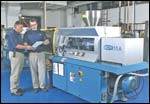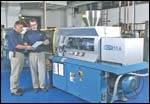Can't We All Just Get Along?
MoldMaking Technology's EAB dispenses advice on how to improve the often-tumultuous relationship between moldmakers and molders.
Communication. Communication. Communication. While it may be the most overused word in this industry, it also is the most important one.
How can the molder/moldmaker relationship be improved?
Derek Beattie, owner of Polysurf Mold Design (Galt, CA), a consulting, mold design and solid modeling company. The molder should be involved from the beginning. It also is important to have everyone who will be involved in the project take a look at the parts and share their thoughts. There should be a systematic communication procedure in place that is followed during each project, such as maintaining up-to-date, accurate records of mold performance and process specific data. Molded part inspection information and mold maintenance/repair records also are critical.
Walt Bishop, executive director of the Society of the Plastics Industry, Moldmakers' Division (Washington, DC). The molder/moldmaker relationship can be improved in two ways. The first is by recognizing that there is a need to have open and frank communication on the project(s) being developed. Nothing should be assumed or taken for granted. The second way is through strategic partnering. If the molder and moldmaker enter into a venture as allies instead of adversaries, the chances for success are significantly improved. When the molder and the moldmaker approach a project with an attitude of "who's going to make the most money," everyone suffers.
Tom Fenton, toolroom manager for Minntech Corp. (Plymouth, MI), a medical device and solutions manufacturer. The moldmaker and the molder should treat each other as stakeholders - not vendors. The most important thing is to have the specifications of the project and mold written down and agreed upon at the start. Keep notes of all meetings, e-mails, faxes and prints in reverse chronological order. Share the meeting notes, and make sure all of the quotes are accurate and readable. Pictures over the Internet are a great way to show progress and will be more helpful when added to the typical progress chart. Follow-up by both parties after the mold is built is critical.
Joe Genc, engineering coordinator of PM Mold (Schaumburg, IL), a total service toolmaking company. There never seems to be enough time to talk things over carefully. To help alleviate this problem, you need to get clean computer files - making sure that you have the proper information to begin with. It is important that the molder and moldmaker have a vendor/partner relationship - where the molder has given the moldmaker a very good snapshot of how his operation works and vice versa.
Jim Koppe, engineering manager for Northwestern Tool and Die (Vernon Hills, IL), a designer and manufacturer of injection molds. All parties need to share as much detail as possible - many times the moldmaker has no understanding as to the critical nature of a feature on the product and how it's used in an assembly or assembly process. With this knowledge, if there are any methods to improve the mold or build it more cost-effectively, they can be considered during the design and build process.
Jean Kroes, owner of J.H. Kroes Consulting (Ottawa, Ontario), a consulting firm specializing in small business matters. As much information as possible should be given to the parties. Ask questions if there is a doubt - don't assume. Everybody wants to have a sufficient amount of time to work with, and communication will give you a lot of it. Clear and concise discussion - two-way communication - is the major moving vehicle in getting the job out with a minimum of delay.
Jim Meinert, former co-owner of Snider Mold (Mequon, WI), which builds large compression, injection, RIM and structural foam molds. We have had great benefits from early involvement with the molder and end user - working as a team. Cash flow for the typical smaller moldmaker is life or death. Our international customers make down payments and progress payments. These are hard to get from domestic customers, especially automotive. With partners and alliances it works better than a bidding war. There is a lot more synergy working together, and the experience helps with future projects.
Louis M. Papp, industry strategist for the Canadian Association of Moldmakers (Windsor, Ontario). You must have constant dialogue. If the two parties can get together prior to the molder accepting the order, then they have an opportunity to work with the end user, know the customer and maybe make some innovative changes in the design. There also has to be a professional confidentiality between the two parties so no one's secrets are revealed.
David Randal, owner and operator of Randal Welding and Machine (Santa Ana, CA), a specialty tool steel welding house. What you want is a handshake partnership. The moment you know you have a project bring the moldmaker on board and make him a part of what's going on. You get a much better result and better cooperation between both parties when you act as partners.
Tony Stefanic, owner of Techline Engineering (Alsip, IL), a consulting, product and mold design company. Improve communication. In today's compressed timeframes, both the molder and the moldmaker must work under difficult conditions. The advent of solid modeling has given the customer the ability to get a mold started with a minimum amount of information, but that is not the only information needed. Today a model appears in your e-mail with a short message to get started. Often it is much later that the remainder of the information arrives, which often results in lost time and errors.
Terry Wohlers, president of Wohlers Associates, Inc. (Fort Collins, CO), an independent consulting firm. View one another as partners. Meet on occasion for lunch, assuming you are not far away from one another. Work together on an experimental project and share the vision, responsibility, risks and rewards. An example experiment would be to try one of the new methods of rapid tooling.
Related Content
Leading Mold Manufacturers Share Best Practices for Improving Efficiency
Precise Tooling Solutions, X-Cell Tool and Mold, M&M Tool and Mold, Ameritech Die & Mold, and Cavalier Tool & Manufacturing, sit down for a fast-paced Q&A focused on strategies for improving efficiencies across their operations.
Read MoreThe Trifecta of Competitive Toolmaking
Process, technology and people form the foundations of the business philosophy in place at Eifel Mold & Engineering.
Read MoreMold Design Review: The Complete Checklist
Gerardo (Jerry) Miranda III, former global tooling manager for Oakley sunglasses, reshares his complete mold design checklist, an essential part of the product time and cost-to-market process.
Read MoreFrom Injection Mold Venting to Runnerless Micro Molds: MMT's Top-Viewed June Content
The MoldMaking Technology team has compiled a list of the top-viewed June content based on analytics. This month, we covered an array of topics including injection mold venting, business strategies and runnerless micro molds. Take a look at what you might have missed!
Read MoreRead Next
Family-Run Molder and Mold Maker Prospers for More Than 50 Years
How does a small, family-owned custom molder remain competitive for 53 years without multiple plants, offshore clients, a specialized market niche, or unique leading-edge technology?
Read MoreAre You a Moldmaker Considering 3D Printing? Consider the 3D Printing Workshop at NPE2024
Presentations will cover 3D printing for mold tooling, material innovation, product development, bridge production and full-scale, high-volume additive manufacturing.
Read MoreHow to Use Continuing Education to Remain Competitive in Moldmaking
Continued training helps moldmakers make tooling decisions and properly use the latest cutting tool to efficiently machine high-quality molds.
Read More








_300x250 4.png;maxWidth=300;quality=90)








.jpg;maxWidth=300;quality=90)







